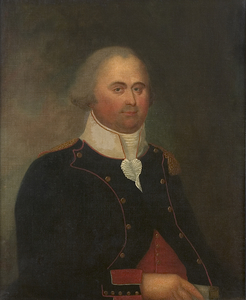
Douville, Pierre (d. 1794)
Role:Dates:
Portrait Location: Library-Annex
Artist: ()
Portrait Date: 1794
Medium: oil on canvas
Dimensions:
Framed Dimensions:
Brown Portrait Number: 35
Brown Historical Property Number: 2237
Pierre Douville was born in 1745 on what is now Canada's Prince Edward Island, then called Ile St. Jean. His father, Francois Jean Douville, was shipwrecked on the island and was thus inadvertently one of its first colonial inhabitants. Like his father, Pierre Douville's life was shaped by the sea. He began his career in trade, sailing ships laden with goods from Canada to New England. As an Acadian, Douville had little reason to be fond of the English, whose deportation of the Acadians living on Ile St. Jean in 1758 resulted in the shipwreck and drowning of most of the unfortunate dispossessed. Perhaps this resentment aided Douville in making his decision to offer his services as an experienced seaman to the American forces during the Revolutionary War, or perhaps it was merely his desire to protect the commercial presence he had established in Pawtucket, Rhode Island, in 1770. Whatever the case, in 1775, Nicholas Cooke, the governor of Rhode Island, proposed Douville as the ideal person to make a risky voyage to France to get gunpowder sorely needed by the colonists' army. Douville was willing to attempt the voyage, but there was no funding to be found, so he joined the American navy instead. Douville captained ships under the command of such naval heroes as John Paul Jones, Abraham Whipple, and Esek Hopkins. For his reconnaissance missions which aided in pinpointing the position of British forces, Douville received military honors. He married Cynthia Aborn of Providence in 1778. Douville settled in Providence and attempted to live the peaceful life of a merchant, but his military prowess proved too valuable for the governments then in conflict to sacrifice. Douville was a French subject and thus felt a duty to respond to the call of his country as it suffered during its revolution. In 1794, in the battle known as "the Glorious First of June," Douville died of eighteen wounds received during the French navy's attempt to protect a shipment of food bound for the starving ports of France from being seized by the British navy's blockaders.
This painting was given to Brown in 1887 by Douville's granddaughters, Miss Cynthia Douville and Mrs. Sarah A. Tinkham. Its painter is unknown, but it is said to have been executed in France in 1794, shortly before Douville's death. Because of its usefulness for the study of military uniforms this portrait is exhibited with the Anne S. K. Brown Military Collection in the Special Collections of the Brown University Library.
